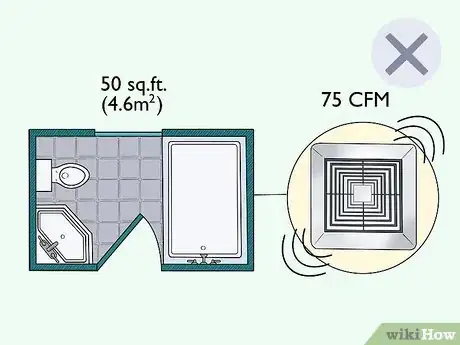This article was co-authored by Mitchell Newman. Mitchell Newman is the Principal at Habitar Design and its sister company Stratagem Construction in Chicago, Illinois. He has 20 years of experience in construction, interior design and real estate development.
There are 7 references cited in this article, which can be found at the bottom of the page.
wikiHow marks an article as reader-approved once it receives enough positive feedback. In this case, 100% of readers who voted found the article helpful, earning it our reader-approved status.
This article has been viewed 410,495 times.
Who doesn’t love a hot, steamy shower? Bathrooms tend to collect more moisture than other rooms in your home, and too much moisture is a recipe for mold and mildew. Fortunately, as long as you have an exhaust fan that can refresh the air, you won’t have any problems. The key is to figure out how strong of a fan your bathroom needs by calculating the CFM, or cubic feet per minute, required to keep the air properly circulating. To make it simple for you, we’ve answered a few of the most common questions that folks have about how to calculate the CFM for a bathroom fan.
Steps
How do you calculate CFM for a bathroom fan?
-
1Measure the dimensions of your bathroom. Use a tape measure to measure each dimension of your bathroom - the length of each wall and the height from floor to ceiling. For a bathroom with a rectangular floor plan, you can keep these numbers in your head for the CFM calculation. If you have an irregular floor plan, you may want to draw and label the plan on paper to help you calculate your bathroom's volume.[1]
-
2Calculate the floor area of your bathroom. For a rectangular bathroom, this is done by multiplying the width and length.[2] For example, a 7 ft x 10 ft (2.1 m x 3 m) bathroom has a floor area of 70 square feet (6.5 square meters). If your bathroom has a more complex shape, break the floor plan into simpler shapes, calculate their areas, and then add those areas together to arrive at the total floor area. Don't ignore the air above the bathtub--it is part of the total volume.Advertisement
-
3Go with 1 CFM for every 1 square foot (0.093 m2) of floor space. Use this rule of thumb to make your calculations simpler. Choose a fan with a CFM that matches your area (or closely matches it).[3]
- For instance, if your bathroom is 75 square feet (7.0 m2), choose a bathroom fan with at least 75 CFM.
-
4Add additional CFM if your ceiling is higher than 8 feet (2.4 m). A higher ceiling means more total volume in your bathroom. Multiply your area by the height of your ceiling and divide that number by 60 (for 60 minutes in an hour). Round up to the next whole number and then multiply that number by 8 (the number of air exchanges in an hour) to get your CFM value.[4]
- For instance, if your bathroom is 60 square feet (5.6 m2) and your ceiling is 10 feet (3.0 m) tall, multiply them together to get 600. Divide 600 by 60 to get 10. Then multiply 10 by 8 to get 80 as the ideal CFM for your fan.
-
5Include fixtures for bathrooms larger than 100 square feet (9.3 m2). Larger bathrooms need an exhaust fan with a little more juice to properly ventilated the room. Find the total area and then add in the CFM requirements for each of these fixtures:[5]
- 50 CFM for each toilet
- 50 CFM for the shower
- 50 CFM for a bathtub
- 100 CFM for a jetted tub
Expert Q&A
-
QuestionHow many CFM do I need for my bathroom fan?
 Mitchell NewmanMitchell Newman is the Principal at Habitar Design and its sister company Stratagem Construction in Chicago, Illinois. He has 20 years of experience in construction, interior design and real estate development.
Mitchell NewmanMitchell Newman is the Principal at Habitar Design and its sister company Stratagem Construction in Chicago, Illinois. He has 20 years of experience in construction, interior design and real estate development.
Construction Professional Typically, they have a minimum of 90. There might be some that are even 60. A lot of them are 90 or 100, and that's totally sufficient for a typical bathroom. I think if you have it, then it tends to be sufficient if you have 100.
Typically, they have a minimum of 90. There might be some that are even 60. A lot of them are 90 or 100, and that's totally sufficient for a typical bathroom. I think if you have it, then it tends to be sufficient if you have 100.
References
- ↑ https://www.tradewindsimports.com/blog/bathroom-exhaust-fan-size-cfm/
- ↑ https://www.todayshomeowner.com/bathroom-vent-fan-cfm-calculator/
- ↑ https://www.bobvila.com/articles/bathroom-fan-size/
- ↑ https://www.bobvila.com/articles/bathroom-fan-size/
- ↑ https://www.hvi.org/resources/publications/bathroom-exhaust-fans/
- ↑ https://www.vmacair.com/blog/whats-the-difference-between-psi-and-cfm/
- ↑ https://www.thisoldhouse.com/bathrooms/21223814/how-to-choose-bathroom-exhaust-fan
- ↑ https://www.thisoldhouse.com/bathrooms/21016422/how-to-upgrade-to-a-bigger-bath-fan
- ↑ https://www.hvi.org/resources/publications/bathroom-exhaust-fans/







































































